

Surface-based Analysis: Inter-subject Registration and Smoothing
Outline • Exploratory Spatial Analysis • Coordinate Systems • 3D (Volumetric) • 2D (Surface-based) • Inter-subject registration • Volume-based • Surface-based • Surface-based smoothing • Surface-based clustering 2
Exploratory Spatial Analysis • Don’t know where effect is going to be • vs ROI analysis • Analyze each voxel separately • Create a map • Find clusters 3
Aging Exploratory Analysis Cortical Thickness vs Aging; Salat, et al, 2004, Cerebral Cortex 4
Aging Thickness Study N=40 Positive Age Correlation Negative Age p<.01 Correlation 5
Individual Exploratory Analysis • fMRI Words-vs-Fixation • Single subject (eg, presurgical planning or functional ROI) • Outlines are FreeSurfer cortical ROIs • Yellow and blue blobs are functional activation • Activation does not lie cleanly within a predefined ROI 6
Exploratory Spatial Analysis • Generally requires spatial smoothing of data to increase SNR • For group analysis, requires that subjects’ brains be aligned to each other on a voxel-wise basis • Neither needed for an ROI analysis • Smoothing and inter-subject registration can be performed in the volume or on the surface 7
Why Is a Model of the Cortical Surface Useful? Local functional organization of cortex is largely 2-dimensional! Eg, functional mapping of primary visual areas: From (Sereno et al, 1995, Science).
Coordinate Systems: 3D (Volumetric) y • 3D Coordinate System • XYZ • RAS (Right-Anterior-Superior) x • CRS (Column-Row-Slice) • Origin (XYZ=0, eg, AC) • MR Intensity at each XYZ z 9
Coordinate Systems: 2D (Surface) Sheet: 2D Coordinate System (X,Y) Sphere: 2D Coordinate System y • Latitude and Longitude (q, f) • Continuous, no cuts central • Value at each point (eg, thickness) x anterior posterior sylvian f superior temporal calcarine q Curvature • SULCUS (+) • GYRUS (-) pial inflated 10
Inter-subject Registration 11
Volumetric Inter-subject Registration • Affine/Linear • Translate • Rotate • Stretch • Shear • (12 DOF) • Match Intensity, Voxel-by-Voxel • Problems • Can use non-linear volumetric (cf CVS) 12
Surface-based Inter-subject Registration Subject 1 Subject 2 Curvature “Intensity” • SULCUS (+) • GYRUS (-) • Codes folding pattern • Translate, Rotate, Stretch, Shear (12 DOF) • Match Curvature, Vertex-by-Vertex • Nonlinear Stretching (“Morphing”) allowed (area regularization) • Actually done on sphere • “Spherical Morph” 13
A Surface-Based Coordinate System Common space for group analysis (like Talairach) 14
fsaverage • Has “subject” folder like individual FS subjects • “Buckner 40” subjects • Default registration space • MNI305 coordinates ?h.average.curvature.filled.buckner40.tif 15
Surface-based Inter-subject Registration • Gray Matter-to- Gray Matter (it’s all gray matter!) • Gyrus-to-Gyrus and Sulcus-to-Sulcus • Some minor folding patterns won’t line up • Fully automated, no landmarking needed • Atlas registration is probabilistic, most variable regions get less weight • Done automatically in recon-all • fsaverage 16
Spatial Smoothing Why should you smooth? • Might Improve CNR/SNR • Improve inter-subject registration How much smoothing? • Blob-size • Typically 5-20 mm FWHM • Surface smoothing more forgiving than volume-based 17
Volume-based Smoothing • Smoothing is 14mm FWHM averaging of “nearby” 7mm FWHM voxels 18
Volume-based Smoothing 14mm FWHM • 5 mm apart in 3D • 25 mm apart on surface! • Kernel much larger • Averaging with other tissue types (WM, CSF) • Averaging with other functional areas 19
Spatial Smoothing • Spatially convolve image with Gaussian kernel. • Kernel sums to 1 • Full-Width/Half-max: FWHM = s /sqrt(log(256)) s = standard deviation of the Gaussian 0 FWHM 5 FWHM 10 FWHM Full-Width/Half-max Full Max 2mm FWHM Half Max 5mm FWHM 10mm FWHM
Effect of Smoothing on Activation • Working memory paradigm • FWHM: 0, 2, 4, 6, 8, 10, 12, 14, 16, 18, 20
Surface-based Smoothing • Smoothing is averaging of nearby vertices Sphere: 2D Coordinate System ( q,f ) Sheet: 2D Coordinate System (X,Y) central anterior posterior sylvian superior temporal calcarine 22
Group fMRI Analysis: Volume vs Surface Surface-based Registration and smoothing Affine registration to MNI305 with volume smoothing Probe-vs-Fixation. Data from Functional Biomedical Informatics Research Network (fBIRN) 23
5HT 4 BP Asymmetry Study (N=16) p<10 -3 Left > Right p<10 -2 p<10 -2 Right > Left p<10 -3 Surface Smoothing Volume Smoothing 24
Surface-based Clustering • A cluster is a group of connected (neighboring) vertices above threshold • Neighborhood is 2D, not 3D • Cluster has a size (area in mm 2 ) • Reduced search space (corrections for multiple comparisons) 25
Summary • Why Surface-based Analysis? – Function has surface-based organization – Inter-subject registration: anatomy, not intensity – Smoothing – Clustering – Like 3D, but 2D Use FreeSurfer Be Happy 26
Recommend
More recommend